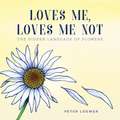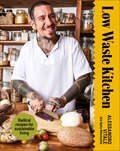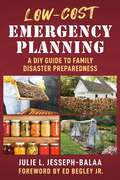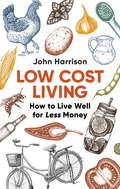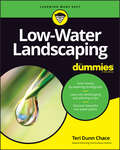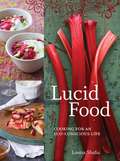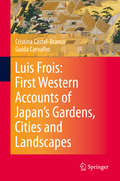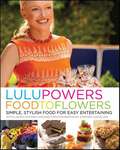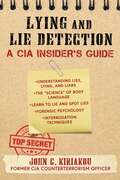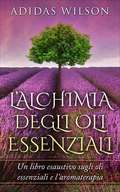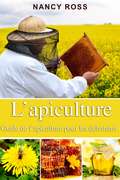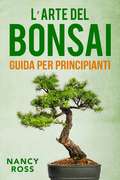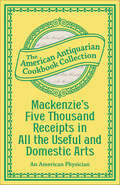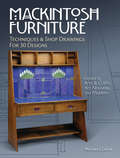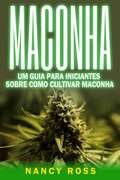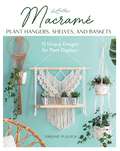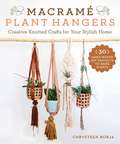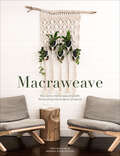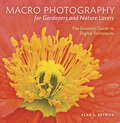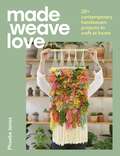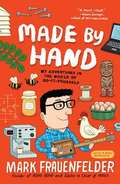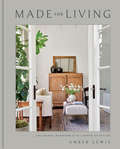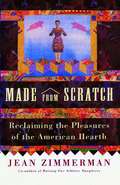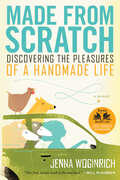- Table View
- List View
Loves Me, Loves Me Not: The Hidden Language of Flowers
by Peter Loewer“A single flow’r he sent me, since we met. All tenderly his messenger he chose; Deep-hearted, pure, with scented dew still wet—One perfect rose.” —Dorothy Parker Welcome to the mysterious and sometimes scandalous world of the language of flowers. Since the days of Queen Victoria (and earlier the harems of the Middle East) flowers have allowed lovers and friends to express themselves without saying a word. In Loves Me, Loves Me Not, author and illustrator Peter Loewer explores the fascinating history of floral messages. In this book you'll find intriguing plant lore, unexpected historical connections, or simply an opportunity to connect with a beloved in a unique way. Confess unrequited love with a daffodil. Show happiness with primroses. Wish someone luck with a four-leaf clover. Make your declaration of love not with a rose, but with a tulip! With intriguing stories and stunning full-color illustrations, Loves Me, Loves Me Not, introduces you to flowers that have been conveying message for centuries. As Loewer says: "The language of flowers is a delightful idea. In the world of cell phones and mass communications, sending a simple bouquet that tells a tale of love and affection seems to be a great idea whose time has come again."
Low Waste Kitchen: Radical Recipes for Sustainable Living
by Alessandro VitaleWelcome to Alessandro Vitale a.k.a SpicyMoutstache’s world, where he’s on a determined mission to reduce waste in your kitchen. Everyone wants to live more sustainably, but it's hard to know where to start. With all those small steps towards zero-waste will come to light. Through 100 step-by-step low-waste recipes, Alessandro Vitale (Spicy Moustache) shows that everyone can make small changes for a big environmental impact. Driven by a desire for a more sustainable world, Alessandro’s success has been his plant-based 60 second videos on maximizing flavor and making the most of different fruit and vegetables. Now, Spicy brings his straightforward approach to the page, with step-by-step low- and zero-waste recipes for delicious plant-based meals and snacks, along with a handful of household remedies, cosmetics, and useful tips on food storage, shopping, and more – everything you need to reduce waste in your kitchen and home.
Low-Cost Emergency Planning: A DIY Guide to Family Disaster Preparedness
by Julie L. Jesseph-BalaaA Guide to Family Emergency Readiness That Doesn&’t Break the Bank It is easy to think that you need a small fortune to make plans and stock up for emergency situations. But this book offers an alternative: that families don&’t need to spend their entire savings to be prepared. A solid plan––combined with common sense habits––can use your family&’s day-to-day lifestyle choices to enhance your survival quotient. In Low-Cost Emergency Planning, learn how to develop practices and repurpose everyday household discards to improve your family&’s readiness for natural and human-made disasters. This book offers advice on the basics, from water and food to hygiene and energy alternatives, with full-color photos and clear instructions. By focusing on sustainable habits and DIY resources for basic household necessities, families can be prepared for anything.
Low-Cost Living 2nd Edition: How to Live Well for Less Money
by John HarrisonWhen economic conditions are tough, we all need to watch our spending. John Harrison's simple, tried and tested methods will help you to enjoy a better standard of living while saving money and helping the environment.Discover the benefits of growing your own fruit and vegetables, raising chickens, making butter, cheese and bread, and brewing your own beer.Save energy, save on your bills.Harvest food for free and avoid waste.Play the supermarkets at their own game and get the best deals.See how to recycle, re-use, make do and mend.Find out if solar power is right for you and whether wind power makes domestic sense.
Low-Water Landscaping For Dummies
by Teri Dunn ChaceSay goodbye to water-guzzling lawns and create beautiful, landscape designs Low-Water Landscaping For Dummies will teach you to preserve one of our most critical natural resources while simultaneously maximizing your curb appeal. Ditch wasteful, inefficient irrigation methods like sprinkler systems and learn how to embrace designs that save water. This book guides you through different styles of landscaping, introduces you to uniquely drought-tolerant plants, and provides solutions for even the trickiest terrains. You can break the cycle of constant watering, without sacrificing the relaxing atmosphere and aesthetic appeal of your outdoor space. Learn how it’s possible to have vibrant, unique, gorgeous landscapes that incorporate grasses, perennials, shrubs, trees, groundcovers, and succulents without wasting hundreds of gallons of water each day. Packed with useful tips, achievable plans, and easy-to-understand instructions, Low-Water Landscaping For Dummies is the only resource eco-conscious gardeners need to design, plant, and enjoy the landscape of their dreams. Design a landscape that fits your space and budget Discover beautiful, drought-tolerant plants Get regional tips to ensure success Troubleshoot common gardening problemsIf you want to protect the environment, save money on water bills, and learn more about drought-tolerant plants, this is the friendly Dummies guide for you.
Lucid Food: Cooking for an Eco-conscious Life
by Louisa ShafiaGreen Your Cuisine with Earth-Friendly Food Choices. With organic and seasonal cooking principles becoming ingrained in today's kitchens, and new buzzwords including locavore and CSA steadily gaining traction, how do we integrate food politics into daily life in ways that are convenient, affordable, and delicious? Lucid Food offers more than eighty-five healthy, eco-oriented recipes based on conscientious yet practical environmental ideals. Sustainable chef and caterer Louisa Shafia demystifies contemporary food issues for the home cook and presents simple, seasonal dishes that follow nature's cycles, such as Baby Artichokes with Fresh Chervil, Apricot Shortcake with Lavender Whipped Cream, and Roasted Tomato and Goat Cheese Soup. Her empowering advice includes how to source animal products ethically and responsibly, support local food growers, and reduce one's carbon footprint through urban gardening, preserving, composting, and more. This cookbook celebrates the pleasures of savoring home-prepared meals that are healthful, honest, pure, additive-free, and transparently made, from the source to the table.
Luis Frois: First Western Accounts of Japan's Gardens, Cities and Landscapes
by Cristina Castel-Branco Guida CarvalhoThis book focuses on Luis Frois, a 16th-century Portuguese Jesuit and chronicler, who recorded his impressions of Japanese gardens, cities and building practices, tea-drinking rituals, Japan’s unification efforts, cultural traditions, and the many differences between Europe and Japan in remarkable manuscripts almost lost to time. This research also draws on other Portuguese descriptions from contemporary sources spanning the years 1543 – 1597, later validated by Japanese history and iconography. Importantly, explorer Jorge Alvares recorded his experiences of discovery, prompting St. Francis Xavier to visit Japan in 1549, thus ushering in the “Christian Century” in Japan.During this long period of accord and reciprocal curiosity, the Portuguese wrote in excess of 1500 pages of letters to European Jesuits that detail their impressions of the island nation—not to mention their observations of powerful public figures such as Oda Nobunaga, Toyotomi Hideyoshi, and Sen no Rikyu. In addition to examining these letters, the authors translated and researched early descriptions of 23 gardens in Kyoto and Nara and 9 important cities—later visited by the authors, sketched, photographed and compared with the imagery painted on 16th-century Japanese screens.However, the data gathered for this project was found mainly within five large volumes of Frois’ História do Japão (2500 pages) and his Treaty on Contradictions—two incomparable anthropological works that were unpublished until the mid-20th century for reasons detailed herein. His volumes continue to be explored for their insightful observations of places, cultural practices, and the formidable historical figures with whom he interacted.Thus, this book examines the world’s first globalization efforts that resulted in profitable commerce, the introduction of Portuguese firearms that changed Japan’s history, scientific advances, religious expansion, and many artistic exchanges that have endured the centuries.
Lulu Powers Food to Flowers: Simple, Stylish Food for Easy Entertaining
by Laura Holmes Haddad Lulu PowersFrom Lulu Powers, one of Los Angeles’s premier caterers and event planners, comes a lively, lushly photographed, full-color cookbook featuring 175 recipes and inspired party-planning tips. Lulu Powers Food to Flowers offers simple, stylish food for easy entertaining—invaluable steps to the perfect party or gathering, from a Coffee and Newspaper Party to a Retro Game Night to a Big City Cocktail Party.
Lying and Lie Detection: A CIA Insider's Guide
by John KiriakouA foolproof guide both to lying and to detecting deception,Lying and Lie Detection: A CIA Insider's Guide will teach you how the pros can tell if and when somebody is lying. People lie all the time. Studies show that the average American lies between six and twenty times a day. Most lies are of the &“little white&” variety or are meant to spare a person&’s feelings. But what about the big lies? What about the consequential ones? You have a right to know when somebody is lying to you. Now, imagine if you had the tools to spot a lie from the truth—a guide to perfect your sixth sense. Whether it's finding out if you truly got the job, unmasking an infidelity, or a simple recommendation, you will no longer have to spend hours, days, or even weeks pondering about it. Through the easy-to-follow instructions and professional anecdotes in Lying and Lie Detection: A CIA Insider's Guide, you&’ll learn to lie and spot lies from John Kiriakou, a former CIA counterterrorism officer and senior investigator for the Senate Foreign Relations Committee responsible for the capture of Abu Zubaydah.Remember, CIA operations officers are trained to lie. They lie all the time. When they are working undercover, they are actually living a lie. With the CIA as a teacher, you&’ll learn how to tell.
L’alchimia Degli Oli Essenziali: Un libro esaustivo sugli oli essenziali e l’aromaterapia
by Adidas WilsonL’ALCHIMIA DEGLI OLI ESSENZIALI Un libro esaustivo sugli oli essenziali e l’aromaterapia di Adidas Wilson La qualità degli oli essenziali (OE) è variabile e, che si sia un aromaterapeuta o un consumatore, valutarla non è semplice. Questi oli vengono prodotti in tutto il mondo e le aziende o i negozianti li ottengono da grossisti o agricoltori di cui conoscono bene la serietà e le procedure. Il consumatore finale non è a conoscenza di tali aspetti e non è in grado di verificarli. Indice Introduzione 1. Cos’è l’aromaterapia? 2. Oli essenziali 3. Oli vettore 4. Diffusori per oli essenziali/diffusori per aromaterapia 5. Benefici dell’olio di eucalipto 6. Benefici dell’aromaterapia 7. Oli essenziali per alleviare il dolore e l’infiammazione 8. Oli essenziali per l’eczema 9. Olio essenziale di canapa 10. Olio essenziale di origano 11. Olio essenziale di citronella 12. Oli essenziali per contrastare le rughe in modo naturale 13. Oli per il trattamento dell’acne 14. Olio essenziale di menta piperita per la crescita dei capelli 15. Oli essenziali per ridurre l’insonnia 16. Ricette per miscele di oli essenziali per il diffusore 17. Oli essenziali per la menopausa 18. Oli essenziali per il trattamento della cellulite 19. Oli essenziali per il trattamento delle verruche 20. Oli essenziali per eliminare la forfora 21. Oli essenziali di agrumi 22. Oli essenziali contro i pidocchi 23. Oli essenziali per alleviare la bronchite 24. Oli essenziali per il trattamento dell’herpes zoster 25. Oli essenziali per le emorroidi 26. Oli essenziali per l’ansia, lo stress e la depressione 27. Oli essenziali per la sinusite 28. Oli essenziali per il raffreddore e la faringite 29. Olio essenziale di lavanda<br/
L’apiculture: Guide de l’apiculture pour les débutants
by Nancy RossDÉCOUVREZ UN MOYEN FACILE DE SE METTRE À L’APICULTURE ! Que vous vouliez produire votre propre miel, stimuler la production de votre jardin potager ou savourer le pur plaisir de l’apiculture, ce livre peut vous aider. Voici un aperçu de ce que vous allez apprendre... Combien de ruches devrais-je avoir ? Où est-ce que je trouve mes abeilles ? Choisir les bonnes fournitures Installer votre ruche Comment récolter le miel Problèmes courants que vous pouvez rencontrer avec l’apiculture Conseils pour réussir dans l’apiculture Et bien plus !
L’arte del bonsai: guida per principianti
by Nancy Ross Barbara ParuttoVolete Apprendere I Concetti Di Base Per la Coltivazione Dei Bonsai? Ecco cosa imparerete con questo libro: Scegliere l’ambiente giusto per il bonsai Fornire al bonsai le sostanze nutritive di cui necessita Potare il bonsai Gli strumenti più utili per prendersi cura del bonsai Rinvasare il bonsai E molto altro ancora!
Mackenzie's Five Thousand Receipts in All the Useful and Domestic Arts
by Antiquarian Collection CookbookPublished in 1829 in Philadelphia, Mackenzie&’s Five Thousand Receipts in All the Useful and Domestic Arts was an unknown &“American physician&’s&” adaptation of a best-selling British reference book by Colin Mackenzie. The book is an all-encompassing miscellanea of household information specifically revised from its original British publication for use in the United States. Covering everything from gardening, metallurgy, and pickling and preserving to watercolors, medical cures, perfumery, brewing, and cooking, this early 19th century compendium was an essential guide for cooking and managing a household during this time period. With the extensive material covered, the tome was very well received in America, as was the original publication in the United Kingdom. Even though the work was first published nearly 200 years ago, the recipes and advice have proven to be relevant today—lip balms citing the book as the recipe source can be found on the Internet, as well as numerous blogs referring to the brewing section of the book. While recipes such as Acorn Coffee, Clove Cordial, and Elephant&’s Milk may only be of historical interest, Mackenzie&’s Five Thousand Receipts in All the Useful and Domestic Arts still has significance today beyond simple historical curiosity. This edition of Mackenzie&’s Five Thousand Receipts in All the Useful and Domestic Arts was reproduced by permission from the volume in the collection of the American Antiquarian Society, Worcester, Massachusetts. Founded in 1812 by Isaiah Thomas, a Revolutionary War patriot and successful printer and publisher, the society is a research library documenting the lives of Americans from the colonial era through 1876. The society collects, preserves, and makes available as complete a record as possible of the printed materials from the early American experience. The cookbook collection comprises approximately 1,100 volumes.This e-book represents original pages from an antique cookbook using digital scans. In order to maintain the integrity and exact representation of this historical book, the original pages have been placed as images, therefore, the text is not searchable and cannot be selected. Please use the table of contents, index, and page numbers to navigate through this e-book as you would a print book.
Mackintosh Furniture: Techniques & Shop Drawings for 30 Designs
by Michael CrowRecreate Mackintosh's Signature Style Architect and designer Charles Rennie Mackintosh designed hundreds of pieces of furniture throughout his career. Ranging in style from Arts & Crafts to Art Nouveau to Modern, his furniture occupies an interesting place in history and had tremendous influence on American and European furniture design.Mackintosh Furniture: Techniques & Shop Drawings for 30 Designs is a guide to recreating Mackintosh's work. The measured drawings in this book were painstakingly rendered using known dimensions from architectural drawings and those extrapolated from catalog and auction photos. You'll find comprehensive views for each design and complete materials lists as well as historical notes and construction and finishing advice to help you through each build. The book features:Shop drawings for 30 Mackintosh furniture designs including chairs, tables, bookcases, desks and many other forms2 complete step-by-step projects (a taboret and a nightstand) showcasing some of Mackintosh's signature furniture detailsHistorical and cultural insight into Mackintosh's impact on architecture and furniture designPractical advice on wood selection, construction, hardware sources and finishing techniquesHelpful tools and techniques adviceOften emulated, Mackintosh's furniture remains popular after more than a century. Now, for the first time ever, fans of his work will have access to drawings and details to help recreate some of his most enduring designs.
Maconha: Um Guia Para Iniciantes Sobre Como Cultivar Maconha
by Nancy Ross Ravi Martins de Almeida SampaioAPRENDA A CULTIVAR MACONHA SOZINHO!! Aqui Está Uma Prévia do Que Você Aprenderá... Benefícios de Cultivar Sua Própria Canabis Cultivo em Ambientes Internos e Externos O Básico Sobre o Cultivo da Canabis Como Lidar Com Pestes e Outros Problemas da Jardinagem Tipos de Sistemas Hidropônicos Colheita Muito, Muito Mais!
Macrame Plant Hangers, Shelves, and Baskets: 15 Unique Designs for Plant Displays
by Virginie Pugliesi Claire CurtSimply beautiful plant hangers you can make yourself!Not sure where to put your plants anymore, or how to best show them off? Hang them up! Bohemian yet chic, inspired by nature and interior design, these charming hangers will make your plants look their best. Even if you've never tried macrame before, the step-by-step instructions with over 300 photos will make it easy for you to complete any of the 15 original designs. There are only 10 knots to learn, and you can learn as you go!A variety of styles for indoor and outdoor use:Fringed holderHanging wall shelfWall basketButterfly hangerHanging basketSuspended log slice And more!
Macramé Plant Hangers: 30 Creative Knotted Crafts for Your Stylish Home
by Chrysteen BorjaAdorn your cozy interiors with hand-woven knotted art and hanging plants.Are you a DIY home decorator, plant lover, or flower lover? We got you!Macramé plant hangers are the perfect little touch to accent your cozy, designer home. Macramé—the art of knotting made popular in the seventies—is now on a revival, bringing trendy boho vibes into your living room, bedroom, and more. And there&’s simply no better way to display your hanging plants than stringing them up in handmade woven knots.Whether you&’re a novice or seasoned knotter, Macramé Plant Hangers provides thirty quirky, yet stunning projects that will spark your DIY artist&’s imagination and get you creating. Follow detailed photographs and instructions to construct patterns with various natural fibers, including cotton rope, felted wool, silk ribbon, jute, recycled fabric, and more. There are knotted projects suitable for bigger eight-inch pots, small four-inch pots, vintage bottles, and even air plants.Including a practical beginner&’s section of knot basics; an introduction to weaving; customizable variations to add playful beads, funky fringes, and chic rope tassels to your macramé design for &“whimsy&”; and a bonus chapter on special projects that mix macramé with a dash of weaving and earthy elements, Macramé Plant Hangers is your handy guidebook to adorning interiors with your own custom hand-knotted, vintage art you can be proud of—while keeping it green!
Macraweave: Macrame Meets Weaving with 18 Stunning Home Decor Projects
by Amy Mullins Marnia Ryan-RaisonDiscover the exciting new craft that brings together two timelessly popular fiber arts to make beautiful, eye-catching pieces for your home. Learn to create stunning woven wall hangings and inject a dose of &“bohemian luxe&” to your living space. Macraweavecombines the crafts of macramé knotting with weaving to create eye-catching projects that really pop with texture and color. There are eighteen projects to choose from including woven wall hangings, table mats, plant hangers and cushions as well as accessories such as jewelry. All the instructions and projects are illustrated with step-by-step photography.
Macro Photography for Gardeners and Nature Lovers: The Essential Guide to Digital Techniques
by Alan L. DetrickGardeners and nature lovers delight in taking pictures—especially close-ups of flowers, butterflies, and insects. And though advances in digital camera technology have made taking, storing, and sharing photos easier than ever, taking top-quality pictures requires familiarity with both digital technology and the general principles of photography. Macro Photography for Gardeners and Nature Lovers provides exactly the information that aspiring photographers—no matter their level of skill—need to take their photos to the next level. Clear and concise chapters cover the basics of macro (close-up) photography, explain the features of current digital single-lens reflex cameras, show the many ways images can be composed, and share tips on digital effects, storage, and manipulation of imagery. Throughout the text, helpful tips, definitions, exercises, and case studies serve to demystify digital photography. Each lesson is supported by examples of the author's stunning photography. Whether taking photos of flowers and insects, compiling a photographic record of your garden, or simply sharing beautiful images with friends and family, everyone can become accomplished photographers of the world's small-scale wonders.
Made Weave Love: 20+ contemporary handwoven projects to craft at home
by Phoebe JonesMaster the art of weaving with over 20 stunning projects Phoebe Jones is on a mission to make weaving accessible to all. In her debut book Made Weave Love Phoebe shows you the joys of weaving and how this gentle and intuitive craft can spark creativity in your life. Covering the very basics from the essential tools and how to build your own loom, to selecting the perfect yarn and finding colour and design inspiration, Phoebe carefully guides you through everything you need to get started.Packed with beautiful photography and step-by-step tutorials throughout, this go-to guide - featuring projects for both beginners and advanced crafters alike - will give you the skills you need to confidently weave gorgeous masterpieces that spread style and colour throughout your home.
Made Weave Love: 20+ contemporary handwoven projects to craft at home
by Phoebe JonesMaster the art of weaving with over 20 stunning projects Phoebe Jones is on a mission to make weaving accessible to all. In her debut book Made Weave Love Phoebe shows you the joys of weaving and how this gentle and intuitive craft can spark creativity in your life. Covering the very basics from the essential tools and how to build your own loom, to selecting the perfect yarn and finding colour and design inspiration, Phoebe carefully guides you through everything you need to get started.Packed with beautiful photography and step-by-step tutorials throughout, this go-to guide - featuring projects for both beginners and advanced crafters alike - will give you the skills you need to confidently weave gorgeous masterpieces that spread style and colour throughout your home.
Made by Hand
by Mark FrauenfelderMark Frauenfelder, cofounder of Boing Boing, the world's most popular blog, goes on a do-it-yourself journey to prove that handmade is a more satisfying way to live.
Made for Living: Collected Interiors for All Sorts of Styles
by Amber Lewis Cat ChenThe trendsetting designer known for her effortless style shares the secrets of the art of layering, with more than 250 gorgeous photographs of her signature interiors. &“Livability is my true north. The materials I use time and again all change with age and wear. Not only is that okay, it&’s how you achieve more than a re-creation of what you&’ve already seen, or what somebody else has done. You can do this, too—I promise.&”—from the introduction Designing a room with all the vibes comes down to how you layer your décor. The more you can mix the elements of your room—your pillows, objects, patterns, and lighting—the more finished it&’ll feel: not too new, not too old, but just right. Known for her eclectic approach that stems from her California cool, Amber Lewis trains your eye in Made for Living, offering friendly advice on everything from nailing that perfect shade of paint to mismatching patterns with wild abandon to choosing a stone finish for new countertops. These pages will help you design a home that's made to be lived in.
Made from Scratch
by Jean ZimmermanIn this stunning celebration and reappraisal of the importance of "women's work," acclaimed journalist Jean Zimmerman poignantly addresses the tug that many Americans of the twenty-first century feel between our professional and private lives. With sharp wit and intelligence, she offers evidence that in the current domestic vacuum, we still long for a richer home life -- a paradox visible in the Martha Stewart phenomenon, in the continuing popularity of women's service magazines such as Better Homes and Gardens, Family Circle, and Ladies' Home Journal -- whose combined circulation of over 17 million is nearly twice the combined circulation of Time, Newsweek, and U.S. News & World Report -- and the booming business of restorations, where onlookers get a hands-on view of domestic life as it flourished in past centuries. This book is about the ways home traditions passed from one generation to the next -- baking a birthday cake from scratch, cherishing family heirlooms, or discovering the satisfaction of piecing a quilt -- sustain our souls, especially in our ever more processed, synthetic world, where we buy "homemade" goods and fail to see the irony in that.Made from Scratch tells the story of the unsung heroines of the hearth, investigating the history of female domesticity and charting its cultural changes over centuries. Zimmerman traces the lives of her own family's homemakers -- from her tiny but indomitable grandmother, who managed a farm, strangled chickens with her bare hands, and sewed all the family clothing, to her mother, who rejected her country upbringing yet kept a fastidious suburban home where the gender divide stayed firmly in place, to her own experiences as a wife and mother weaned on the Women's Movement of the 1970s, with its emphatic view that housework was a dirty word and that the domestic sphere was to be fled rather than cherished. In this book Zimmerman questions the unexamined trade-off we have made in a shockingly brief time span, as we've "progressed" from home-raised chickens to frozen TV dinners to McNuggets from the food court at the mall. What is lost when we no longer engage, as individuals and as a community, in the ancient rituals of food, craft, and shelter?
Made from Scratch: Discovering the Pleasures of a Handmade Life
by Jenna WoginrichIn a hectic world of mass-produced food, clothing, and entertainment, it’s easy to miss out on the simple pleasures of doing things for yourself. Young web designer Jenna Woginrich chronicles her adventures as she learns to embrace the idea of self-sufficiency in all aspects of her life, including sewing her own clothes, growing her own food, and creating her own fun outside of the mainstream. Woginrich’s hilarious, heartbreaking, and soul-satisfying journey will bring joy and inspiration to those who dream about a more independent lifestyle.
